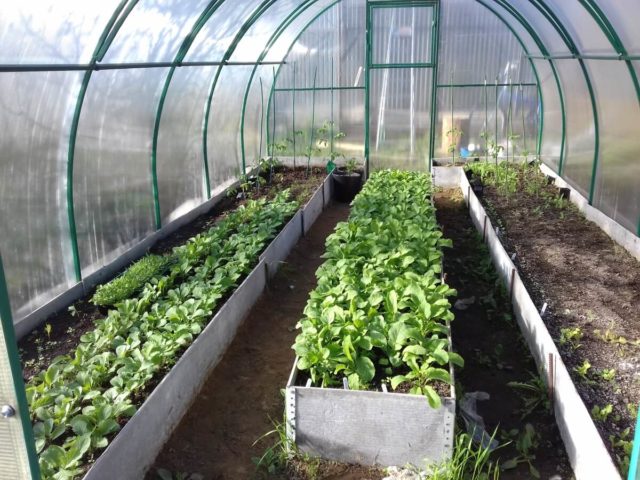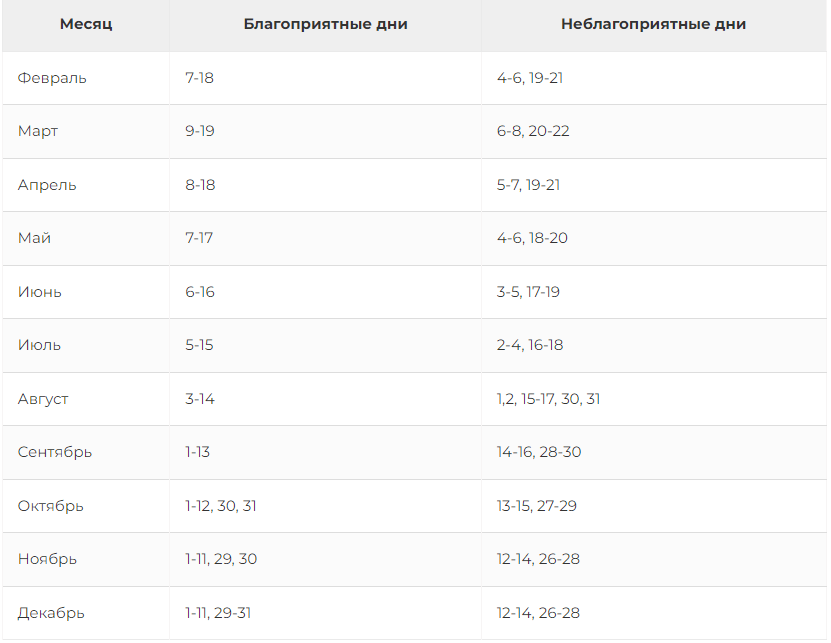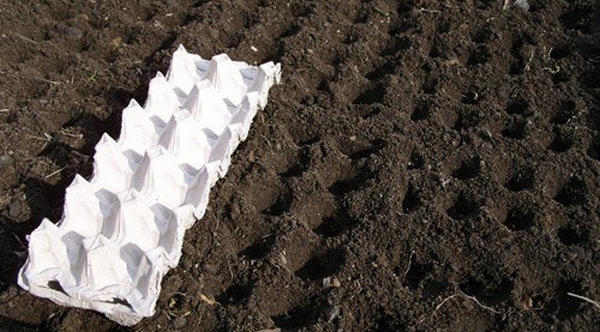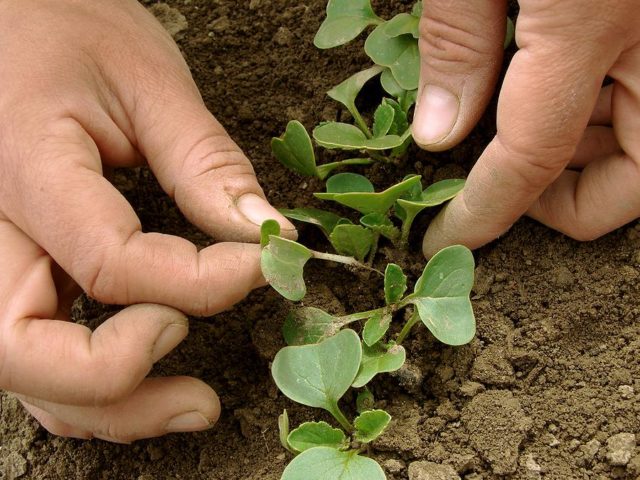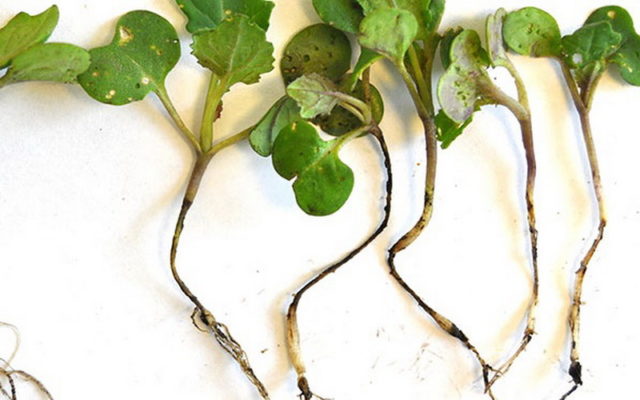Content
- 1 Advantages of early planting of radishes in a polycarbonate greenhouse
- 2 Radish varieties for early planting in a greenhouse
- 3 When to sow radishes in a greenhouse
- 4 When to plant radishes in a greenhouse in the regions
- 5 When can you plant radishes in a greenhouse in the spring according to the lunar calendar 2023
- 6 Preparing the greenhouse for planting
- 7 How to plant radishes in a greenhouse in early spring
- 8 How to grow radishes in a greenhouse in early spring
- 9 Possible problems during cultivation
- 10 Pests and diseases
- 11 Conclusion
At the beginning of spring, in many regions of Russia it is still quite cold, but the increasing daylight hours and the sun beginning to noticeably warm up already make it possible to carry out some agricultural work. Planting radishes in a greenhouse in early spring is one of the most common ways to start the gardening season.It allows you not only to get early vegetables, but also to reuse the greenhouse by planting cucumbers, tomatoes or peppers after harvesting root crops.
Advantages of early planting of radishes in a polycarbonate greenhouse
Radishes traditionally start the gardening season. This crop is resistant to low temperatures and unpretentious in cultivation. Radish has quite a few varieties with ripening periods of less than 1 month, so this crop is ideally suited for early sowing in greenhouses. Radish seeds can germinate at temperatures from + 3 °C and above, but the plant can grow and develop normally at temperatures from + 10 °C. In polycarbonate-based structures, it is quite possible to ensure such conditions already in early spring. Therefore, sowing radishes in such greenhouses can be done as early as March-April.
Polycarbonate is an excellent heat-insulating material, quite lightweight and durable. It transmits light perfectly. The bright spring sun quickly warms up such a greenhouse, and the porous structure of polycarbonate retains heat for a long time.
Radish varieties for early planting in a greenhouse
To grow radishes in a polycarbonate greenhouse in the spring, choose ultra-early and early varieties with a ripening period of about 3-4 weeks. Thus, by the middle or end of May the harvest is fully ripened. This allows you to carry out all the necessary work on processing the greenhouse and prepare it for planting more heat-loving crops, which are planted in late May or early June.
The following radish varieties are suitable for early planting in polycarbonate greenhouses:
- Firstborn F
- CelesteF
- Ultra early red.
- Early red.
- Heat.
- French breakfast.
When to sow radishes in a greenhouse
It is possible to plant radishes in polycarbonate greenhouses in the spring in many regions by the end of March and the beginning of April; the ground inside them has completely thawed by this time, and air temperatures do not drop to negative values even at night. When the soil warms up to + 5-7 °C, you can start sowing radish seeds. In greenhouses with individual heating, sowing can be done even earlier.
In heated
Radishes can be grown in heated greenhouses all year round. However, it must be remembered that short daylight hours in winter are clearly not enough for the normal development of plants, therefore in such structures, in addition to heating, it is necessary to equip additional artificial lighting.
In an unheated
It is difficult to name the exact timing of planting radishes in spring in greenhouses without additional heating, since each region has its own climatic characteristics. In this case, you need to focus on the air temperature in the greenhouse. If it does not drop below 0 °C even at night, then you can start planting.
When to plant radishes in a greenhouse in the regions
Due to the climate characteristics of various regions of Russia, the timing of planting radishes in unheated greenhouses is shifted to earlier or later. In addition to temperature indicators, solar activity is also of great importance. Both the yield and the ripening time of vegetables directly depend on the number of sunny days, because it is the energy of our luminary that heats the air and soil in unheated greenhouses.
In outskirts of Moscow
You can sow radishes in a greenhouse in the Moscow region as early as the end of March. At this time of year, most areas of the metropolitan region are already without snow cover.Thanks to good solar activity, the soil in polycarbonate greenhouses by the beginning of April is already warm enough to begin planting radishes. If spring is late (which is not uncommon for the Moscow region), then planting can be done 1-2 weeks later.
In the Urals
The climate of the Urals differs significantly from that of the Moscow region. However, when planting radishes in a greenhouse, this difference is largely leveled out. The Ural region is quite large, so the timing of planting work here is highly dependent on the geographical features of the area and solar activity. You can start planting radishes in a greenhouse in the Urals in April, additionally focusing on local climatic conditions.
In Siberia
In Siberia, snow cover can last for quite a long time. However, in the southern regions, due to the abundance of sunny days, greenhouses warm up quite quickly. In mid-April, the soil in the greenhouse is already warm enough for planting radishes, but it is imperative to take measures to protect against low temperatures at night, since the likelihood of night frosts at this time is still extremely high.
When can you plant radishes in a greenhouse in the spring according to the lunar calendar 2023
Many gardeners and gardeners believe that it is possible to plant radishes correctly in a greenhouse in the spring only by focusing on the lunar calendar. This practice can be viewed in different ways, but the influence of our natural satellite on the growth and development of plants undoubtedly exists. It is believed that on the waxing Moon the above-ground part of plants develops more intensively, while the waning Moon promotes the development of the root part.
The full moon and new moon phases are periods of rest; it is not recommended to disturb the plants at this time.
In March
Since the radish crop ripens underground, when planting you need to focus on the days in which the Moon is in its waning phase. Based on this condition, as well as taking into account the passage of the Earth’s satellite through the zodiacal constellations, the most optimal days for spring sowing of radishes were determined. In March, such days are from the 9th to the 19th.
In April
April 8-18 is favorable for sowing radishes in greenhouses. However, this does not mean that if you sow on other days, there will be no harvest. The lunar calendar is only one of the factors influencing the yield of garden crops. It would be wrong to focus only on it, without taking into account the particular climate of the region or weather conditions.
Preparing the greenhouse for planting
Cleaning, washing and disinfection of polycarbonate greenhouses is carried out in the fall, after harvesting. If the structure was not used during the winter, then re-treatment is not necessary. It is also better to dig up the soil in the fall; it is better to combine this with the application of organic matter and mineral potassium-phosphorus fertilizers. Before planting radishes, it will be enough to lightly loosen the soil with a hoe or flat cutter, and then level the beds with a rake.
How to plant radishes in a greenhouse in early spring
Plant radish seeds in furrows or holes. They should be shallow, 1-2 cm. Place them on the bed at a distance of 20 cm from each other. Before planting, the grooves are moistened, and then the seeds are placed in them at a distance of 3-5 cm from each other. Maintaining these distances avoids competition between neighboring plants, so the plantings then do not have to be thinned. After planting, the seeds are sprinkled and watered again.
How to grow radishes in a greenhouse in early spring
Radishes are quite unpretentious, but certain care measures still need to be taken. The following activities must be carried out:
- watering;
- loosening the soil;
- weed removal;
- fertilizing
How long does it take for radishes to sprout in a greenhouse?
Radishes sprout quite quickly. The first shoots may appear within 4-6 days from planting. If the ground is not warm enough, seedlings may appear much later. Therefore, you should not rush with planting; intensive plant growth will not begin until the temperature in the soil reaches + 8-10 ° C.
How often to water radishes in a greenhouse
For normal radish growth, the soil must be loose and moist, so regular watering is very important. If the weather is sunny, then the soil in the greenhouse dries out quite quickly. You need to water radishes in a greenhouse daily, making sure that moisture penetrates 15-20 cm into the soil. Lack of watering can provoke the growth of arrow shoots. It is preferable to use settled and slightly warm water, so the containers are usually placed directly in the greenhouse. During the day, the water warms up well and settles, and in the evening it can be used for irrigation.
Thinning and loosening the soil
The top layer of soil must be loosened regularly, destroying the resulting crust. This will help maintain normal air exchange in the soil, which is extremely important for the establishment and growth of root crops. If planting was carried out in compliance with the required intervals between seeds, then thinning out the seedlings is not required.If the plantings are thickened, then culling should be carried out by thinning the plants, as well as removing weak shoots.
It is also necessary to periodically remove weeds, which will thrive in greenhouse conditions and can choke out radish plantings, especially at an early stage.
How to feed radishes in a greenhouse
At an early stage, radishes in a greenhouse can be fed with nitrogen, stimulating the process of increasing green mass. However, nitrogen-containing fertilizers must be used with great caution, since their excess will lead to uncontrolled growth of tops to the detriment of the formation of root crops. After the underground part of the plant begins to set, you should apply
How long does it take for radishes to ripen in a greenhouse?
Most gardeners prefer to plant ultra-early and early varieties of radish in greenhouses with a ripening period of 20 to 30 days. However, unfavorable conditions, especially low temperatures, can significantly lengthen the ripening time of root crops. The commercial maturity of radishes is quite easy to determine, since the upper part of the root crop is open and located above the surface of the ground.
Some gardeners divide the greenhouse area into several beds, planting radishes on them with different ripening periods or with a planting delay of 10-15 days. This allows you to significantly extend the harvest time, relieving the gardener of the need to quickly consume or process a large number of root crops in a limited time.
Educational video about growing radishes in a greenhouse:
Possible problems during cultivation
Radish is an unpretentious plant, but a number of problems may arise when growing it.Here are the most common ones.
- Soil inconsistency. Radishes prefer loose sandy loam or loamy moist soils with good air permeability, with a reaction close to neutral. With any deviations from these conditions, changes in plant development will be noticeable, expressed in slower growth, yellowing of leaves, and the appearance of diseases.
- Disorders in care. First of all, this concerns non-compliance with planting deadlines, significant deviations from the watering schedule, violation of the length of daylight hours, and non-compliance with recommended temperature parameters. In this case, instead of forming a root crop, the radish may grow into an arrow. An excess of fertilizers, especially nitrogen-containing ones, can lead to the same result.
What to do if the radishes are very stretched in the greenhouse
When planted in a greenhouse, radishes may stretch for several reasons. The most common of them are too high daytime temperatures and dense plantings. To avoid this, it is necessary to regularly ventilate the greenhouse and not allow the daytime temperature in it to rise above + 20-22 °C. You also need to monitor the density of the crops, thinning them in a timely manner.
Pests and diseases
When growing early radishes in a greenhouse, the likelihood of plant damage by pests is low. Many insects are still in the ground during the ripening period of the radish harvest, only emerging after hibernation, and therefore only a small part of them can harm the crops.
Various viral and fungal diseases, the appearance of which is usually a consequence of improper care, can cause much greater harm to radishes. Among the most common radish diseases are the following:
- Kila.
- Blackleg.
- Powdery mildew.
- Downy mildew.
- Mosaic.
- Bacteriosis.
- Gray rot.
The main risk factors are high air humidity at elevated temperatures, as well as dense plantings. To prevent diseases, you should regularly inspect the plantings, promptly remove diseased plants and carry out sanitary treatment. To prevent fungal diseases, various fungicides are most often used, as well as folk remedies: infusions of onions, garlic, celandine, tobacco and other herbs.
Conclusion
Planting radishes in a greenhouse in early spring allows you to make more efficient use of time and the sown area of your personal plot. In addition, this is a good way to increase your vegetable diet by supplementing it with this tasty and healthy root vegetable. Planting and caring for radishes in a greenhouse is quite simple; they do not require special knowledge and skills. You just need to follow the necessary recommendations for growing these plants, and the result will not be long in coming.
